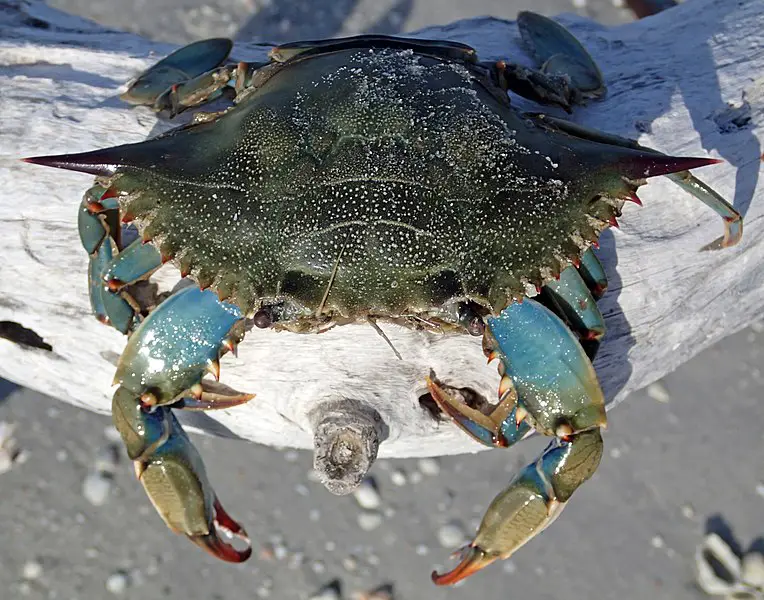Blue crabs are incredibly beautiful and interesting creatures, and depending on who you ask, they can also make wonderful additions to any pond. That being said, blue crabs do have needs for their environment, just as any animal does. However, generally speaking, yes, blue crabs can live in freshwater ponds and tanks.
Blue crabs live in freshwater areas that, naturally, are tailored to their exacting needs for survival. Just like any marine creature, they will need the right kind of nourishment, temperature, habitats, and occasionally, even some saltwater. So, how can you help a blue crab to thrive in a freshwater tank or pond?
In order for them to survive for longer than a few months, blue crabs need environments that are much like their natural habitats. In the wild, blue crabs live in both freshwater and saltwater, as well as brackish water (the in-between option). You will therefore need to regularly add saltwater and brackish water to a freshwater tank or pond.
Can blue crabs breed in freshwater?
Generally speaking, yes, blue crabs can breed in freshwater tanks or ponds, but it needs to be adequate for them to do so. In the wild, blue crabs typically mate from May to October. They do so in salty waters, so the freshwater should have some saltwater introduced into them fairly regularly, to maintain the right environment for the blue crabs.
Then, once the females are ready to lay their eggs, they usually migrate to even saltier waters, where they burrow in the mud. The larvae then usually migrate to the Atlantic Ocean, which is obviously pretty salty! After a few months, they will return to fresher waters where they will fully mature and live out their lives.
Blue crabs can breed in freshwater, but it is thought to be particularly difficult and not necessarily easy to control. While it has been achieved in the past, it does require a lot of dedication and care – meaning that if you’re just getting started with a freshwater tank, these may be critters you ‘work your way up to’. If you are unsure about how to proceed, it could be best to avoid breeding blue crabs altogether – but it’s always a good idea to reach out to a local expert or breeder who can help along the way.
Can blue crabs live in freshwater lakes?
Blue crabs can indeed survive in freshwater lakes, but it may not be the best habitat for them. While managing a freshwater pond or tank can be relatively straightforward (in comparison). As we have seen, blue crabs need varying levels and migratory like changes in their environment in order to survive.
If you do plan on keeping blue crabs, it would be best to have them in their own freshwater pond or tank, in which you can better control the environment without damaging the environment for other species. That being said, blue crabs live in freshwater lakes that you may find all over the world. However, managing your own larger body of water is a task that’s going to need a lot of time and effort!
Lakes such as Lake Mattamuskeet and Lake George are perfect for blue crabs as they are blends of freshwater and saltwater, which is perfect for this particular species. In fact, they are often bred there for commercial purposes. So, in order for blue crabs to thrive in a lake, they’d need the perfect balance – after all, they wouldn’t grow and evolve there in the wild if the conditions were less than perfect!
Can crabs survive in freshwater?
That all really depends on the types of crab you are thinking about – there are thought to be more than 1,300 different crab species that will happily breed, live and thrive in freshwater lakes and tanks. There could be as many as 2,100, but regardless, this is around 20-30% of all known crab species. So yes – the vast majority will do better in saltwater or brackish water conditions.
Crabs survive in freshwater when they are adapted to do so. As you may expect, freshwater is vastly different from the saltwater of oceans and wider seas, as the salinity is much lower. Marine life that live and breed in freshwater have physically evolved to adapt to the lower salt and the additional water volume that may arrive alongside.
That’s why it is always important to ensure you know whether you are caring for a freshwater crab or a saltwater crab. Placing either species in alternating water types could prove fatal – which is why you must prepare a tank, pond or otherwise that is built for their specific evolutionary needs. It can be an easy mistake to make, but it is just as simple to avoid.
Can blue crabs reproduce in freshwater?
It can be difficult for blue crabs to reproduce in freshwater, but the issue isn’t as much with the breeding as it is with the needs of the young. Generally speaking, blue crab larvae go to saltwater as they grow and only return to freshwater as they mature. Therefore, it’s a careful balance between what works for younger crabs and what works for older species.
In a freshwater tank or pond, it can be difficult to meet the requirements of the young while having a balanced habitat for the mature blue crabs. That being said, there are of course some very successful crab farms, in which the younger species reach maturity safely. Of course, the pond needs to be regularly modified with the right levels of saltwater and nutrients for them to feed and grow healthily.
Blue crabs can reproduce in freshwater without much encouragement, but It is also important to remember that the temperature of a tank or pond needs to be perfectly balanced for the older species. Generally speaking, it is better for blue crabs to grow in the wild, where they can find their ideal environments alone – in terms of nutrients, temperatures and pH levels.


